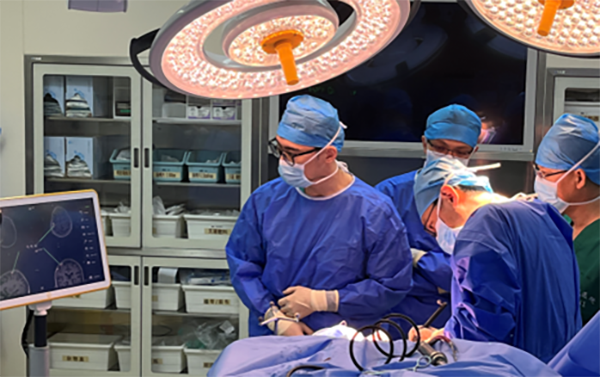
By Xiong Jian, Zhao Jingfan Yang, wearing an air-filled glove on his right hand, firmly held a cup, lifted it, took a sip, and put it back down. This simple action, which most people take for granted, is a miraculous feat for Yang, as he has been bedridden for 14 years due to a car accident that left him paralyzed.
The technology that enabled him to go from paralysis to being able to “drink water with his mind” is called brain-computer interface (BCI) technology.
On Jan. 29, Professor Zhao Guoguang’s team from Xuanwu Hospital affiliated with Capital Medical University, and Professor Hong Bo’s team from the School of Medicine, Tsinghua University announced a groundbreaking advancement in the treatment of quadriplegia caused by cervical spinal cord injury using an implanted BCI with epidural electrode. The patient in this case was exactly Yang, who underwent the BCI surgery in October last year.
BCI typically refers to the use of devices to capture electrical activity inside the brain and create a direct communication pathway, allowing signals to connect the brain with a computer and thus enabling “mind control of computers.”
Technically, to make Yang’s right-hand move again despite his quadriplegia, it takes a three-step process.
The first step was to find a suitable “landing point” for the BCI processor.
On Oct. 24, 2023, the two teams completed the first clinical implantation trial of a wireless BCI processor called Neural Electronic Opportunity (NEO).
Specifically, two coin-sized BCI processors were implanted into Yang’s skull by a neurosurgeon, enabling the successful collection of neural signals from the motor cortex.
“These two processors each have four contact points, totaling eight, placed on the motor cortex of Yang’s brain that controls his right hand,” said Zhao.
“How did we locate this area? Before the surgery, we used functional magnetic resonance imaging to determine the activation area of the brain, which allowed us to find it,” he explained.
This was not easy at all. Zhao gave an analogy, saying, “It’s like walking into a soccer stadium with 30,000 to 40,000 spectators all cheering at the same time, and we have to detect what two people in the 80th row of the south stand are saying. Moreover, the brain has not just thousands, but millions of cells, so you can imagine the difficulty.”
In the second step, after the area was determined, the appropriate technique was chosen to implant the device into the brain.
How was the BCI processor implanted? The Chinese teams achieved two breakthroughs in wireless minimally invasive procedures.
On one hand, they implanted the NEO within the skull, with the electrodes covering the outer layer of the dura mater, ensuring the quality of intracranial signals without damaging the neural tissues. On the other hand, they utilized near-field wireless power supply and signal transmission, eliminating the need for batteries in the implanted intracranial device.
The third step was to “decode” the brain signals into computer language.
Ten days after a successful surgery, Yang was discharged from the hospital and returned home. When using the system at home, the external device needed to be placed over the scalp to provide power to the implanted device and receive the neural signals from the brain. These signals were then transmitted to a computer or smartphone, ultimately enabling communication through the BCI.
“We encountered countless millisecond-level electrical signals, and without analyzing them, we would have no idea what they represented. Therefore, decoding is crucial,” said Zhao.
“What do we decode them into? We decode them into a code that computers understand, which is 0 and 1. Once decoded, they could be transformed into various real-life scenarios, such as controlling an air-filled glove to grasp objects, operating an electric wheelchair, or even turning on and off a television. All these actions can be controlled through the power of thought,” Zhao explained.
After three months of rehabilitation at home, Yang is now able to use his brain activity to control the air-filled glove, which enables him to independently drink water and make other movements. Moreover, his accuracy in grasping objects has exceeded 90 percent.
“We are especially grateful to Yang, who was the first to try this groundbreaking technology. It demonstrated his strong vitality and desire for recovery,” said Zhao.
“Thanks to the BCI technology, Yang has shown significant improvement within three months. This is not only inspiring for patients and their families, but also medical staff, engineering technicians, and equipment manufacturers, motivating us to explore more unknown territories,” Zhao told People’s Daily.
The concept of BCI has been around for 50 years. In recent years, research in this field has become a hot pursuit for countries worldwide.
The future applications of BCI technology are incredibly diverse. By recording and interpreting brain signals, it enables direct communication between the brain and computers. This technology not only holds the potential to aid in the rehabilitation of patients with brain disorders such as ALS, spinal cord injuries, and epilepsy but also can achieve brain-computer fusion intelligence and expand the capabilities of the human brain in information processing.
“There is no greater joy for us as doctors than being able to relieve patients’ pain and help them regain a normal life,” Zhao said.










